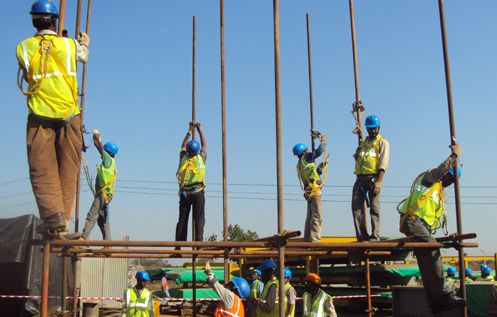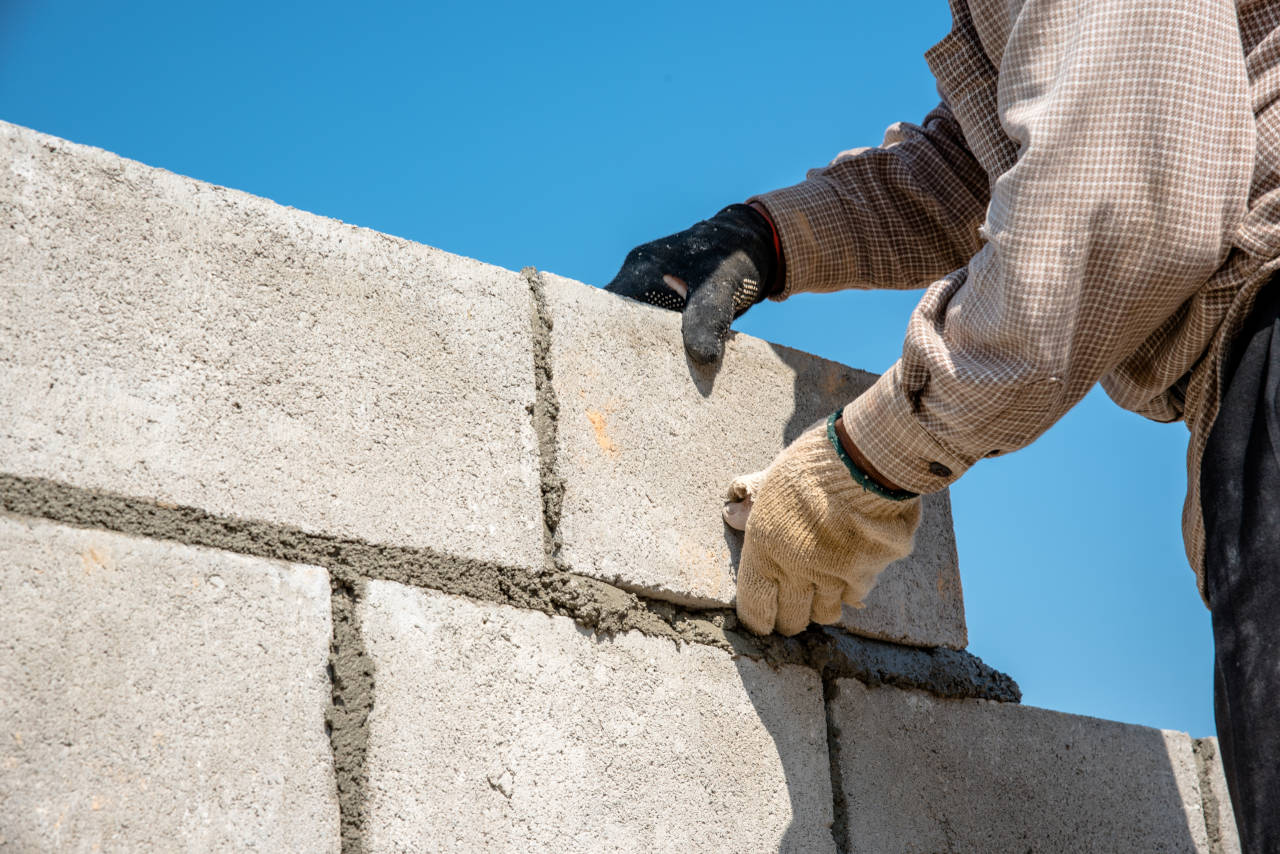Mason Stone (6 month course)
Mason Stone click here
Brief Job Description
Mason stone is responsible for identifying, cutting, shaping, laying, fixing and finishing the various stones
on different surfaces using appropriate tools and equipment as per specified standards, pattern and within dimensional accuracy.

Personal Attributes
The mason stone is expected to be physically fit to work across various locations with varied
environmental conditions. The person should be organized, diligent, methodical, safety-conscious, and a
prompt decisionmaker. In addition to being a team player, the individual should have good communication skills.
Apply grouts and sealants for flooring and cladding works
Description
This unit describes the skills & knowledge required to check for voids and uses grouts to seal joints for tile, stone, marble, and granite for flooring and cladding works
Scope
The scope covers the following :
Carry out preparatory work for grouting of tile, stone, marble, and granite works
Apply grout and sealant to seal the void or gap between the tiles, stones, marble, and granite
Check for line, level & alignment
Elements and Performance Criteria
Carry out preparatory work for grouting of tile, stone, marble and granite works
To be competent, the user/individual on the job must be able to:
PC1. read and interpret the working drawings / sketches prior to commencement of work
PC2. ensure curing of placed stone, marble & granite tiles
PC3. ensure joints of tiles are free from debris & carry out vacuum cleaning of the grout lines
PC4. remove thoroughly old grouting compound with appropriate tools prior to re-grouting on old
surface
PC5. prepare different types of grouts as per surface requirements and manufacturers
specifications
PC6. check grout material is of approved color and shade & as per pattern
PC7. check that grout material is of approved type (sanded, un sanded, ) as per design/pattern
requirements
Apply grout and sealant to seal the void or gap between the tiles, stones, marble & granite
To be competent, the user/individual on the job must be able to:
PC8. apply the grout between grout lines/joints using appropriate tool
PC9. press the grout into the joint using appropriate tools and technique
PC10. handle grout float edge properly and prevent it from digging out the grout lines
PC11. use appropriate amount of penetrating sealant on the stones prior to fixing as per
applicability
PC12. remove excess grout from the surface to avoid any grout haze on the surface
PC13. check and ensure that the grout was cured prior to application of sealant
PC14. polish the surface after application of grout in case of epoxy grouts for better aesthetics and
smoother joints
PC15. add additive to cementations grouts as a substitute for water as per specifications
PC16. ensure proper care is taken for moisture sensitive and light colored natural stones to prevent
strain ingress
PC17. ensure proper protective layer at the corners(tile trims/strips) of tiled surfaces
Check for line , level & alignment
To be competent, the user/individual on the job must be able to:
PC18. check and provide required level and specified slope
PC19. check vertical and horizontal alignment using appropriate tools
Knowledge and Understanding (KU)
The individual on the job needs to know and understand:
KU1. standard practices for grouting works
KU2. safety rules and regulations for handling and storing relevant tools, equipment, and
materials for relevant works in accordance with organizational norms
KU3. importance of personal protection including the use of related safety gears & equipment in
accordance with organizational norms
KU4. service request procedures for tools, materials and equipment as per organizational norms
KU5. procedure for maintenance of tools and equipment
KU6. simple sketches for tiling works
KU7. basic principles of measurement
KU8. standard specification of all grouting tools and materials along with their care and
maintenance
KU9. manufacturers instructions on grout suitability, mixing, curing and application to ensure
optimum performance
KU10. how to select and use tools and equipment such as: measuring tape/rule, trowels, grout
floats, surface cleaning sponges
KU11. different types of grouts used for respective tiles /stones including: cement based grout :
Sanded / Non Sanded epoxy based grout

KU12. different types of process used to prepare the respective grouts for tiles and stones
KU13. standard procedure applicable for the application of grouts on the vertical or the horizontal
surface
KU14. different types of liquid polymeric additives (mostly blends of acrylics and latex) added to
cementations grout and their effect
KU15. how to match grout with approved color and shades, as per design
Generic Skills (GS)
User/individual on the job needs to know how to:
GS1. write in at least one language, preferably in the local language of the site
GS2. read sketches/routine work drawings, instructions provided for the work, and various
signboards, safety rules, safety tags, exit route information in one or more languages,
preferably in the local language of the site
GS3. speak in one or more language, preferably one of the local language at the site
GS4. communicate orally and effectively with team members
GS5. analyze the safety aspect of the workplace
GS6. plan work and organize required resource effectively
GS7. complete work as per agreed time schedule and quality parameters
GS8. resolve any conflict within the teammates
GS9. evaluate the complexity of the tasks
GS10. identify any violation of safety norms during the work
Mark and cut natural stones as per design pattern
Description
This unit describes the skills and knowledge required to measure, mark and cut natural stones as per the
design requirements
Scope
The scope covers the following :
Carry out preparatory works for cutting of natural stones
Cut and shape the natural stones into desired shape and size as per the design pattern
Elements and Performance Criteria
Carry out preparatory works for cutting of natural stones
To be competent, the user/individual on the job must be able to:
PC1. read and interpret work drawings or sketches
PC2. measure dimensions of surface and ensure its adequacy for laying of natural stones
PC3. carry out necessary markings on surface to provide direction for laying of natural stone
PC4. ensure the stone is free from any damage /cracks
PC5. clean the surface of the natural stones of any grease, dust, clay and any other dirt material
Cut and shape the natural stones into desired shape and size as per the design pattern
To be competent, the user/individual on the job must be able to:
PC6. mark the pattern for cutting ensuring adequate markings for electrical and plumbing
requirements
PC7. cut and grind the natural stone to desired shape and size as per design pattern using
appropriate tools.
PC8. prepare the sides, edges & bed of stone for proper bonding
Knowledge and Understanding (KU)
The individual on the job needs to know and understand:
KU1. standard practices for marking and cutting natural stones
KU2. safety rules and regulations for handling and storing relevant tools, equipment, and
materials for relevant works in accordance with organizational norms
KU3. importance of personal protection including the use of related safety gears & equipment in
accordance with organizational norms
KU4. service request procedures for tools, materials and equipment as per organizational norms
KU5. procedure for maintenance of tools and equipment
KU6. basics sketches of the area / surface on which stones are to be laid
KU7. basic techniques and principles for surface preparation prior to laying stones
KU8. measurement of stones and stone covered area
KU9. different types of natural stones such as Granite, Marble, Limestone, Soapstone, Travertine,
Onyx, Slate, Quartzite, etc.
KU10. basic properties and use of different types of natural stones
KU11. standard specification of all masonry tiling tools and materials required for laying of natural
stones along with their care and maintenance
KU12. how to select and use basic tools and tackles for laying stones such as: measuring tape/rule,
hammers, mallets, wedges, power wet saws like Circular saw, Specialty rail saw
KU13. various techniques / procedures for cutting natural stones to the respective shape and size
as per design requirements
Generic Skills (GS)
User/individual on the job needs to know how to:
GS1. write in at least one language, preferably in the local language of the site
GS2. read sketches/routine work drawings, instructions provided for the work, and various
signboards, safety rules, safety tags, exit route information in one or more languages,
preferably in the local language of the site
GS3. speak in one or more language, preferably one of the local language at the site
GS4. communicate orally and effectively with team members
GS5. analyze the safety aspect of the workplace
GS6. plan work and organize required resource effectively
GS7. complete work as per agreed time schedule and quality parameters
GS8. resolve any conflict within the teammates
GS9. evaluate the complexity of the tasks
GS10. identify any violation of safety norms during the work
Work effectively in a team to deliver desired results at the workplace
Description
This unit describes the skills and knowledge required to work effectively within a team to achieve the
desired results
Scope
The scope covers the following :
Interact and communicate in an effective manner
Support co-workers to execute the project requirements
Practice inclusion
Elements and Performance Criteria
Interact and communicate in an effective manner
To be competent, the user/individual on the job must be able to:
PC1. pass on work related information/ requirement clearly to the team members
PC2. inform co-workers and superiors about any kind of deviations from work
PC3. report any unresolved problem to the supervisor immediately
PC4. obtain instructions from superiors and respond on the same
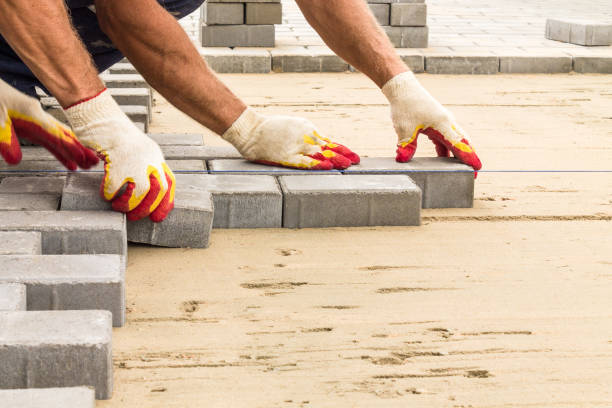
PC5. communicate to team members/subordinates for appropriate work technique and method
PC6. seek clarification and advice as per the requirement
Support co-workers to execute the project requirements
To be competent, the user/individual on the job must be able to:
PC7. hand over the required material, tools, tackles, equipment and work fronts timely to
interfacing teams
PC8. work together with co-workers in a synchronized manner
Practice inclusion
To be competent, the user/individual on the job must be able to:
PC9. maintain cultural inclusivity at work place
PC10. maintain disability friendly work practices
PC11. follow gender neutral practices at workplace
PC12. address discriminatory and offensive behaviour in a professional manner as per
organizational policy
Knowledge and Understanding (KU)
The individual on the job needs to know and understand:
KU1. own roles and responsibilities
KU2. importance of effective communication
KU3. the consequence of poor teamwork on project outcomes, timelines, safety at the
construction site, etc.
KU4. different modes of communication used at workplace
KU5. importance of creating healthy and cooperative work environment among the gangs of
workers
KU6. different activities within the work area where interaction with other workers is required
KU7. applicable techniques of work, properties of materials used, tools and tackles used, safety
standards that co-workers might need as per the requirement
KU8. importance of proper and effective communication and the expected adverse effects in case
of failure relating to quality, timeliness, safety, risks at the construction project site
KU9. importance and need of supporting co-workers facing problems for the smooth functioning of
work
KU10. the fundamental concept of gender equality
KU11. how to recognize and be sensitive to issues of disability, culture and gender
KU12. legislation, policies, and procedures relating to gender sensitivity and cultural diversity
including their impact on the area of operation
User/individual on the job needs to know how to:
GS1. write in at least one language, preferably in the local language of the site
GS2. read the communication regarding work completion, materials used, tools and tackles used,
the resource required, etc,
GS3. speak in one or more languages, preferably in one of the local language of the site
GS4. listen and follow instructions / communication shared by superiors/ co-workers regarding
team requirements or interfaces during work processes
GS5. communicate orally and effectively with co-workers considering their educational and social
background
GS6. decide on what information is to be shared with co-workers within the team or to the
interfacing gang of workers
GS7. plan work and organize the required resources in coordination with team members
GS8. complete all assigned task in coordination with team members
GS9. take initiative in resolving issues among co-workers or report the same to superiors
GS10. ensure best ways of coordination among team members
GS11. evaluate the complexity of task and determine if any guidance is required from superiors
Plan and organize work to meet expected outcomes
Description
This unit describes the knowledge and the skills required for an individual to plan and organize own work in order to meet expected outcome
Scope
The scope covers the following :
Plan and prepare for work
Organise required resources as per work plan
Complete work as per the plan
Elements and Performance Criteria
Plan and prepare for work

To be competent, the user/individual on the job must be able to:
PC1. identify the targets and timelines set by superiors
PC2. determine the work requirements corresponding to
task(drawings/schedules/instructions/methodology), safety, tools and equipment prior to
commencement of task
PC3. plan the work by analyzing the required outcomes, work procedures, allotted time, resource
availability and known priorities
PC4. prepare the work areas in coordination with team members
PC5. plan for waste collection and disposal prior to and after completion of work
Organise required resources as per work plan
To be competent, the user/individual on the job must be able to:
PC6. arrange the required manpower prior to commencement of work
PC7. organize the required materials, tools and tackles required for the task
Complete work as per the plan
To be competent, the user/individual on the job must be able to:
PC8. engage allocated manpower in an appropriate manner
PC9. employ correct tools, tackles and equipment for the desired work
PC10. provide guidance to the subordinates to obtain desired outcome
PC11. use resources in an optimum manner to avoid any unnecessary wastage
PC12. use tools, tackles and equipment carefully to avoid damage
PC13. ensure the work processes adopted are in line with the specified standards and instructions
PC14. complete the work with the allocated resources within specified time
PC15. clean and organize the workplace after completion of task
Knowledge and Understanding (KU)
The individual on the job needs to know and understand:
KU1. importance of proper housekeeping including safe waste disposal
KU2. policies, procedures and work targets set by superiors
KU3. how to identify work activities that need to be planned and organized
KU4. how to determine the task requirements
KU5. how to determine the quality requirements related to the task
KU6. how to undertake all aspect of planning and organizing the task, including interpretation of
task, reading drawing/schedules, arranging resources, reporting problems etc.
KU7. how to implement the planned activities
KU8. how to use available resources in a judicious and appropriate manner to minimize wastages or
damage
Generic Skills (GS)
User/individual on the job needs to know how to:
GS1. write in one or more language, preferably the local language at the site
GS2. read communication from co-workers, superiors and notices from other departments as per
requirement of the level
GS3. speak in one or more language, preferably one of the local language at the site
GS4. follow communication shared by co-workers regarding standard work processes, resources
available, timelines, etc.
GS5. communicate effectively with co-workers and subordinates
GS6. decide on what sequence is to be adopted for execution of work
GS7. plan and organize the materials, tools, tackles and equipment required to execute the work
GS8. complete all assigned task with proper planning and organizing
GS9. analyze areas of work which could result in a delay of work, wastage of material or damage
to tools and tackles
GS10. evaluate potential solutions to minimize avoidable delays and wastages at the construction
site
Work according to personal health, safety and environment protocols at construction site
Description
This NOS covers the skill and knowledge required for an individual to work according to personal health,
safety and environmental protocols at construction site
Scope
The scope covers the following :
Follow safety norms as defined by organization
Adopt healthy & safe work practices
Implement good housekeeping and environment protection process and activities
Follow infection control guidelines as per applicability
Elements and Performance Criteria
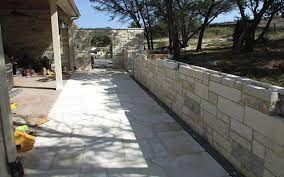
Follow safety norms as defined by the organization
To be competent, the user/individual on the job must be able to:
PC1. identify and report any hazards, risks or breaches in site safety to the appropriate authority
PC2. follow emergency and evacuation procedures in case of accidents, fires, natural calamities
PC3. follow recommended safe practices in handling construction materials, including chemical
and hazardous material whenever applicable
PC4. follow all the protocols and safety techniques conveyed during safety awareness programs
like Tool Box Talks, safety demonstrations and mock drills conducted at the site
PC5. select and operate different types of fire extinguishers corresponding to various types of fires
as per EHS guideline
PC6. identify near miss, unsafe condition and unsafe act
Adopt healthy & safe work practices
To be competent, the user/individual on the job must be able to:
PC7. use appropriate Personal Protective Equipment (PPE) as per work requirements for : Head
Protection, Ear protection, Fall Protection ,Foot Protection, Face and Eye Protection, Hand
and Body Protection , and Respiratory Protection (if required)
PC8. handle all required tools, tackles, materials and equipment safely
PC9. follow safe disposal of waste, harmful and hazardous materials as per EHS guidelines
PC10. check and install all safety equipment as per standard guidelines
PC11. follow safety protocols and practices as laid down by site EHS department
PC12. obtain “height pass” clearance for working at heights
Implement good housekeeping practices
To be competent, the user/individual on the job must be able to:
PC13. collect, segregate and deposit construction waste into appropriate containers based on their
toxicity or hazardous nature
PC14. apply ergonomic principles wherever required
Follow infection control guidelines as per applicability
To be competent, the user/individual on the job must be able to:
PC15. follow recommended personal hygiene, workplace hygiene and sanitization practices
PC16. clean and disinfect all materials, tools and supplies before and after use
PC17. report immediately to concerned authorities regarding signs and symptoms of illness of self
and others
Knowledge and Understanding (KU)
The individual on the job needs to know and understand:
KU1. reporting procedures in cases of breaches or hazards for site safety, accidents, and
emergency situations as per guidelines
KU2. types of safety hazards at construction sites
KU3. basic ergonomic principles as per applicability
KU4. the procedure for responding to accidents and other emergencies at site
KU5. use of appropriate personal protective equipment based on various working conditions
KU6. importance of handling tools, equipment, and materials as per applicable norms
KU7. effect of construction material on health and environments as per applicability
KU8. various environmental protection methods as per applicability
KU9. storage of waste including non-combustible scrap material and debris, combustible scrap
material and debris, general construction waste and trash (non-toxic, non-hazardous), any
other hazardous wastes and any other flammable wastes at the appropriate location
KU10. how to keep the workplace neat and tidy so as to be safe
KU11. how to use hazardous material in a safe and appropriate manner as per applicability
KU12. types of fire
KU13. procedure of operating different types of fire extinguishers
KU14. safety relevant to tools, tackles, and equipment as per applicability
KU15. housekeeping activities relevant to task
KU16. ways of transmission of infection
KU17. ways to manage infectious risks at the workplace
KU18. different methods of cleaning, disinfection, sterilization, and sanitization
KU19. symptoms of infection like fever, cough, redness, swelling, and inflammation
Generic Skills (GS)
User/individual on the job needs to know how to:
GS1. write in at least one language, preferably in the local language of the site
GS2. fill safety formats for near miss, unsafe conditions and safety suggestions
GS3. read in one or more language, preferably in the local language of the site
GS4. speak in one or more language, preferably in one of the local language of the site
GS5. listen to instructions/communication shared by site EHS and superiors regarding site safety,
and conducting the toolbox talk
GS6. identify potential safety risks and report to the appropriate authority
GS7. assess and analyze areas which may affect health, safety and environment protocol on the
site
Carry out dry cladding works with natural stones
Description
This OS unit describes the knowledge and the skills required to carry out dry cladding works with natural
stones
Scope
The scope covers the following :
Store the stones and prepare the surface for cladding works
Perform dry cladding works using natural stones as per requirements
Elements and Performance Criteria
Store the stones and prepare the surface for cladding works
To be competent, the user/individual on the job must be able to:
PC1. ensure natural stones is stored in a safe and accessible manner when not in use
PC2. ensure stone slabs are placed in vertical position to prevent contact with earth surface
PC3. read/interpret work drawings/sketches for cladding works
PC4. check existing wall surface for cracks and undulations
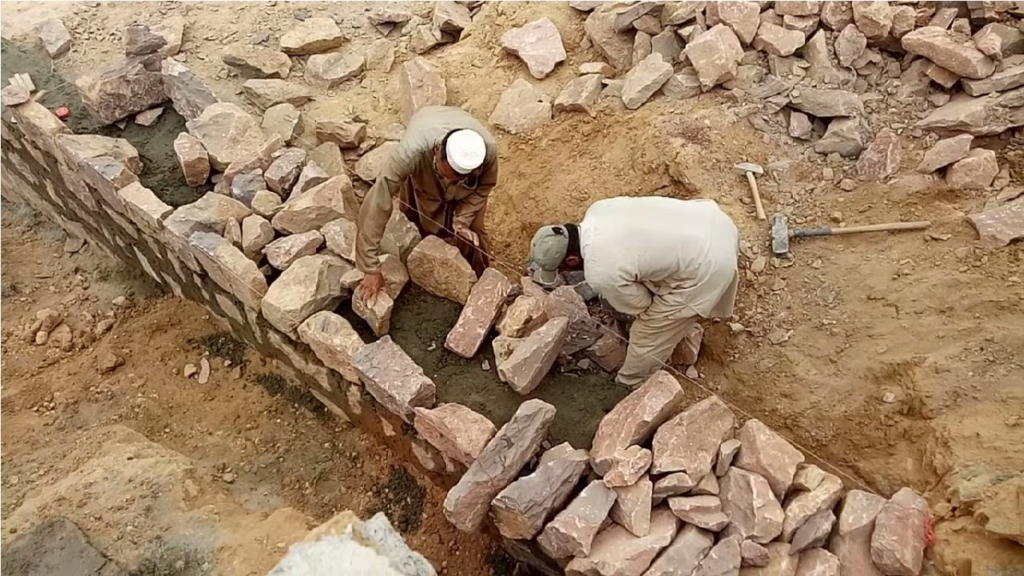
PC5. check surface for squareness, slope, surface plane, & compactness
PC6. install button marks or level pads prior to commencement of cladding works
PC7. carry out necessary markings on surface to provide direction for laying of natural stones
PC8. check surface for completion of embedded surfaces and make necessary provisions for the
same
Perform dry cladding works using natural stones as per requirements
To be competent, the user/individual on the job must be able to:
PC9. select and use suitable anchoring tools and ensure adequate anchorage of steel anchors as
per standard practices
PC10. drill holes to secure anchors on walls for dry cladding as per markings and drawings
PC11. fix anchors/angles, fasteners and other accessories in the wall for maintaining proper
alignment in horizontal and vertical direction
PC12. place stones as per standard method for dry cladding works and secure the same by suitable
method
PC13. maintain specified gap between back wall and stone lining to provide for adequate drainage
in dry cladding works
PC14. check line, level & alignment of cladding works as per requirement
Knowledge and Understanding (KU)
The individual on the job needs to know and understand:
KU1. standard practices for dry cladding works
KU2. safety rules and regulations for handling and storing relevant tools, equipment, and
materials for relevant works in accordance with organizational norms
KU3. importance of personal protection including the use of related safety gears & equipment in
accordance with organizational norms
KU4. service request procedures for tools, materials and equipment as per organizational norms
KU5. procedure for maintenance of tools and equipment
KU6. basics sketches of the area / surface on which stones are to be laid
KU7. basic techniques and principles for preparation of vertical surfaces for cladding works
KU8. basic principles of measurement
KU9. different types of natural stones
KU10. process of handling, shifting and placing of natural stones
KU11. procedure to be followed for dry cladding with natural stones
KU12. basic properties, and use of different types of natural stones
KU13. standard specification of all tools and materials required for cladding works
KU14. care and maintenance required for the respective tools and equipment’s
KU15. how to select and use basic tools and tackles for stone
KU16. use of anchoring tools for cladding works
KU17. tools and techniques used for cutting natural stones to the specified shape and size
KU18. difference between wet and dry cladding
KU19. use of mechanical ties and anchor clip for dry cladding
KU20. use of anchoring tools for cladding works
KU21. special work requirements related to the imported marble, granite etc. for dry cladding work
Generic Skills (GS)
User/individual on the job needs to know how to:
GS1. write in at least one language, preferably in the local language of the site
GS2. read sketches/routine work drawings, instructions provided for the work, and various
signboards, safety rules, safety tags, exit route information in one or more languages,
preferably in the local language of the site
GS3. speak in one or more language, preferably one of the local language at the site
GS4. communicate orally and effectively with team members
GS5. analyze the safety aspect of the workplace
GS6. plan work and organize required resource effectively
GS7. complete work as per agreed time schedule and quality parameters
GS8. resolve any conflict within the teammates
GS9. evaluate the complexity of the tasks
GS10. identify any violation of safety norms during the work
Carry out wet cladding works with natural stones
Description
This OS unit describes the knowledge and the skills required to carry out wet cladding works with natural
stones
Scope
The scope covers the following :
Store the stones and prepare the surface for wet cladding works
Perform wet cladding works using natural stones as per requirements
Elements and Performance Criteria
Store the stones and prepare the surface for wet cladding works
To be competent, the user/individual on the job must be able to:
PC1. ensure natural stones is stored in a safe and accessible manner when not in use
PC2. ensure stone slabs are placed in vertical position to prevent contact with earth surface
PC3. read/interpret work drawings/sketches for cladding works
PC4. check existing wall surface for cracks & undulations
PC5. check surface for squareness, slope, surface plane, & compactness
PC6. install button marks or level pads prior to commencement of cladding works
PC7. carry out necessary markings on surface to provide direction for laying of natural stones
PC8. check surface for completion of embedded surfaces and make necessary provisions for the
same
PC9. ensure cement mortar is prepared as per requirement and specification
Perform wet cladding works using natural stones as per requirements
To be competent, the user/individual on the job must be able to:
PC10. apply cement mortar as per specifications and requirements
PC11. fix angles and fasteners for wet cladding works and place stones as per standard method
using specified mortar for bonding
PC12. carry out grouting and pointing between stones
PC13. maintain grooves in stone slabs as per drawing/pattern and fill the same with appropriate
joint sealant
PC14. remove excess mortar from joints, edges using appropriate tools
PC15. check line, level & alignment of cladding works as per requirement
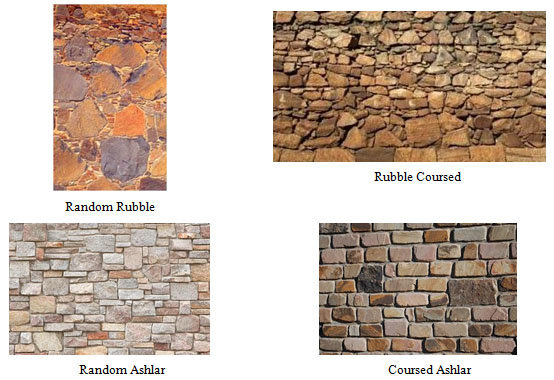
Knowledge and Understanding (KU)
The individual on the job needs to know and understand:
KU1. standard practices for wet cladding works
KU2. safety rules and regulations for handling and storing relevant tools, equipment, and
materials for relevant works in accordance with organizational norms
KU3. importance of personal protection including the use of related safety gears & equipment in
accordance with organizational norms
KU4. service request procedures for tools, materials and equipment as per organizational norms
KU5. procedure for maintenance of tools and equipment
KU6. basics sketches of the area / surface on which stones are to be laid
KU7. basic techniques and principles for preparation of vertical surfaces for cladding works
KU8. measurement of stones and stone covered area
KU9. different types of natural stones
KU10. process of handling, shifting and placing of natural stones
KU11. procedure to be followed for wet cladding with natural stones
KU12. basic properties, and use of different types of natural stones
KU13. standard specification of all tools and materials required for cladding works
KU14. care and maintenance required for the respective tools and equipments
KU15. how to select and use basic tools and tackles for stone
KU16. use of anchoring tools for cladding works
KU17. tools and techniques used for cutting natural stones to the specified shape and size
KU18. difference between wet and dry cladding
KU19. use of mechanical ties and anchor clip for dry and wet cladding
KU20. use of anchoring tools for cladding works
KU21. special work requirements related to the imported marble, granite etc. for wet cladding work
Generic Skills (GS)
User/individual on the job needs to know how to:
GS1. write in at least one language, preferably in the local language of the site
GS2. read sketches/routine work drawings, instructions provided for the work, and various
signboards, safety rules, safety tags, exit route information in one or more languages,
preferably in the local language of the site
GS3. speak in one or more language, preferably one of the local language at the site
GS4. communicate orally and effectively with team members
GS5. analyze the safety aspect of the workplace
GS6. plan work and organize required resource effectively
GS7. complete work as per agreed time schedule and quality parameters
GS8. resolve any conflict within the teammates
GS9. evaluate the complexity of the tasks
GS10. identify any violation of safety norms during the work
Carry out flooring works for natural stones
Description
This OS unit describes the knowledge and the skills required to carry out flooring works with natural stones
Scope
The scope covers the following :
Carry out preparatory works prior to flooring works
Lay, place and fix the natural stones for flooring works
Finish and polish natural stones
Elements and Performance Criteria
Carry out preparatory works prior to flooring works
To be competent, the user/individual on the job must be able to:
PC1. read and interpret work drawings or sketches
PC2. ensure surface is free from any debris or obstructions
PC3. measure dimensions of surface and ensure its adequacy for laying of natural stones
PC4. check base surface for squareness, slope & surface plane
PC5. carry out necessary markings on surface to provide direction for laying of natural stone
PC6. check surface for completion of embedded surfaces and make necessary provisions for the
same
PC7. install button marks or level pads as per requirements
PC8. ensure preparation of suitable mortar using cement, sand and water in required ratio
PC9. ensure preparation of bed mortar, cement slurry and cement paste as per specification
Lay and Fix Natural Stones for flooring works
To be competent, the user/individual on the job must be able to:
PC10. determine alignment and lay floor patterns using appropriate tools
PC11. apply cement paste / adhesives on the base of the stone and set the natural stone in place
as per the design or pattern
PC12. check for hollowness of set stones using wooden mallet
PC13. fill any depressions / gaps with suitable patching material
PC14. pour and spread mortar or grout on natural stones as per applicability
PC15. perform surface finishing work by rubbing and grinding using appropriate tools
PC16. polish the natural stone by using sand and water, pumice stone and machine as per
applicability
Knowledge and Understanding (KU)
The individual on the job needs to know and understand:
KU1. standard practices for laying and fixing natural stones
KU2. safety rules and regulations for handling and storing relevant tools, equipment, and
materials for relevant works in accordance with organizational norms
KU3. importance of personal protection including the use of related safety gears & equipment in
accordance with organizational norms
KU4. service request procedures for tools, materials and equipment as per organizational norms
KU5. procedure for maintenance of tools and equipment
KU6. basics sketches of the area / surface on which stones are to be laid
KU7. basic techniques and principles for preparation of vertical surfaces for cladding works
KU8. measurement of stones and stone covered area
KU9. different types of natural stones such as Granite, Marble, Limestone, Soapstone, Travertine,
Onyx, Slate, Quartzite, etc.
KU10. basic properties and use of different types of natural stones
KU11. standard specification of all masonry tiling tools and materials required for laying of natural
stones along with their care and maintenance
KU12. how to select and use basic tools and tackles for laying stones such as measuring tape/rule,
hammers, mallets, wedges, power wet saws like Circular saw, Specialty rail saw, etc.
KU13. process of handling, shifting and placing of tiles and natural stones
KU14. various techniques / procedures for cutting natural stones to the respective shape and size
as per design requirements
KU15. methods and techniques of preparing bed mortar, cement slurry and cement paste required
as per types of surface and natural stone
KU16. properties of mortar and its mix proportion ratios
KU17. method of fixing stones for flooring works
KU18. methods and techniques of finishing and polishing of stones
Generic Skills (GS)
User/individual on the job needs to know how to:
GS1. write in at least one language, preferably in the local language of the site
GS2. read sketches/routine work drawings, instructions provided for the work, and various
signboards, safety rules, safety tags, exit route information in one or more languages,
preferably in the local language of the site
GS3. speak in one or more language, preferably one of the local language at the site
GS4. communicate orally and effectively with team members
GS5. analyze the safety aspect of the workplace
GS6. plan work and organize required resource effectively
GS7. complete work as per agreed time schedule and quality parameters
GS8. resolve any conflict within the teammates
GS9. evaluate the complexity of the tasks
GS10. identify any violation of safety norms during the work
Carry out mosaic and terrazzo flooring works
Description
This unit describes the skills and knowledge required to carry out mosaic and terrazzo floor finishes
Scope
The scope covers the following :
Carry out mosaic flooring
Carry out terrazzo flooring
Elements and Performance Criteria
Carry out mosaic flooring
To be competent, the user/individual on the job must be able to:
PC1. ensure preparation of the surface of floor and make appropriate markings as per design
PC2. calculate the quantity of materials required for the mosaic flooring work
PC3. lay an underlying layer of concrete in specified ratio and thickness
PC4. prepare a base course of lime, marble and pozzolana material in specified ratio
PC5. cut and fix baton strips as per requirement to form panels
PC6. cut or break tiles, stone or other materials and place them as per design patterns and
drawings
PC7. embed the broken tiles, marble pieces into base layer using stone roller
PC8. rub off surface to polish and smoothen the mosaic /terrazzo design surface
PC9. ensure proper curing of floor for a specified period of time prior to use
Carry out terrazzo flooring
To be competent, the user/individual on the job must be able to:
PC10. ensure preparation of the surface of floor and make appropriate markings as per design
PC11. calculate the quantity of materials required for the terrazzo flooring work
PC12. lay an underlying layer of concrete in specified ratio and thickness
PC13. cut and fix baton strips as per requirement to form panels
PC14. mix epoxy mix with hardener and spread it within the strips as per applicability
PC15. prepare and spread an aggregate mix containing glass, marble, stone or chips with or
without color pigment as per specification
PC16. grind and polish the terrazzo floor once its thoroughly dry
PC17. ensure proper curing of floor for a specified period of time prior to use
Knowledge and Understanding (KU)
The individual on the job needs to know and understand:
KU1. standard practices of flooring works
KU2. safety rules and regulations for handling and storing relevant tools, equipment, and
materials for relevant works in accordance with organizational norms
KU3. importance of personal protection including the use of related safety gears & equipment in
accordance with organizational norms
KU4. service request procedures for tools, materials and equipment as per organizational norms
KU5. procedure for maintenance of tools and equipment
KU6. basics sketches of the area / surface on which flooring is to be done
KU7. basic principles of measurement along with simple geometry that may be required for
flooring
KU8. basic techniques / methods of mosaic and terrazzo flooring on surfaces
KU9. standard specification of all flooring tools and materials along with their usage
KU10. methods of preparing surfaces for applications of mosaic and terrazzo flooring
KU11. methods of mosaic and terrazzo flooring
KU12. method of calculation of material required for mosaic and terrazzo flooring
Generic Skills (GS)
User/individual on the job needs to know how to:
GS1. write in at least one language, preferably in the local language of the site
GS2. read sketches/routine work drawings, instructions provided for the work, and various
signboards, safety rules, safety tags, exit route information in one or more languages,
preferably in the local language of the site
GS3. speak in one or more language, preferably one of the local language at the site
GS4. communicate orally and effectively with team members
GS5. analyze the safety aspect of the workplace
GS6. plan work and organize required resource effectively
GS7. complete work as per agreed time schedule and quality parameters
GS8. resolve any conflict within the teammates
GS9. evaluate the complexity of the tasks
GS10. identify any violation of safety norms during the work


